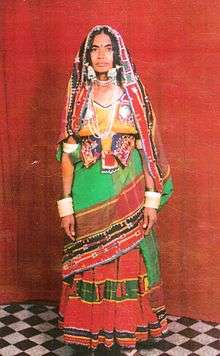Banjara
 | |
| Languages | |
|---|---|
| Lambadi |
The Banjara (also called Gor, Lambani, Vanjara and " Gawaria Gormati) are a community usually described as nomadic people from the northwestern belt of the Indian subcontinent (from Afghanistan to the state of Rajasthan) now spread out all over India.
Origin
According to Burman the name Laman[1] was popular long before the name Banjara, and Laman Banjaras originally came from Afghanistan before settling in Rajasthan and other parts of India. The Lamans, according to him, are originally from the independent province called Gor in Afghanistan.[2]
Banjaras were traditionally suppliers of bullock and salt merchants. The word Banjara is said to be derived from Sanskrit word vana chara (wanderers in jungle). The word Lambani or Lamani is derived from Sanskrit word lavana (salt) which was the principal good they transported across the country.[3]
Culture
Language
Banjaras speak Gor Boli; also called Lambadi, it belongs to the Indo-Aryan group of languages. Most Banjaras today are bilingual or multilingual adopting the predominant language of their surroundings.[4]
Art
Banjara art is rich and includes performance arts such as dance and music to folk and plastic arts such as rangoli, textile embroidery, tattooing and painting.[5] The Banjara embroidery and tattooing are especially prized and also form a significant aspect of the Banjara identity. Lambani women specialize in lepo embroidery which involves stitching pieces of mirror, decorative beads and coins onto clothes.[6] The Sandur Lambani Embroidery is a type of textile embroidery unique to the tribe in Sanduru, Bellary district, Karnataka. It has obtained a GI tag.[7]
Festivals
Banjara people celebrate the festival of Teej during Shravana (the month of August). In this festival young unmarried Banjara girls pray for a good groom.[8] They sow seeds in bamboo bowls and water it three times a day for nine days and if the sprouts grow "thick and high", it is considered as good omen. During Teej the seedling-baskets are kept in the middle and girls sing and dance around them.[8] Banjaras also celebrate the festival of Holi.[9] Banjaras have a sister community of singers known as Dadhis or Gajugonia[10] They are Muslim Banjaras who traditionally traveled from village to village singing songs to the accompaniment of sarangi.[11]
Religion
The banjara people worship same as like Hindus.[12] They also worship gods like Balaji, Jagadamba Devi or Tulja Bhavani, Ganesh, Mahadev, Khandoba/Kanhoba and Hanuman. They also hold Guru Nanak in great respect.
Sevalal or Sevabhaya is the most important saint of the Banjaras. According to Banjara accounts he was born on 15 February 1739 in Sirsi, Karnataka, to Bhima Naik and Dharmini Bai, and died on 4 December 1806. A cattle merchant by profession he is said to have been a man of exemplary truthfulness, a great musician, a courageous warrior, a rationalist who fought against superstition and a devotee of Goddess Jagadamba.[13] The colonial British administrators also quote his stories but they place him in the 19th century and identify his original name as Siva Rathode.[14]
Society
Distribution
Banjaras can be found all over India but their population is concentrated in the states of Rajasthan, Karnataka, Andhra Pradesh, Maharashtra and Telangana. As of 2012 there are 1.1 million Banjaras in Karnataka.[15]
In India, Banjara people were transporters of goods from one place another and the goods they transported included salt, grains, firewood and cattle. During 18th Century, the British colonial authorities brought the community under the purview of Criminal Tribes Act of 1871. By enforcing this act the British Raj curbed the movement of Banjara people.[16] The stigma attached to this continued until 1952 when the Act was abolished by the newly Independent India.
Classification
In some states of India, they are listed as OBC while in other states they are categorised as Scheduled Caste and Scheduled Tribe.[17] In the state Rajasthan and Maharashtra, they are Nomadic tribe (NT) category.[18] In the state of Tamil Nadu they are Backward Classes (BC) and in Karnataka they are categorized as Scheduled Caste since 1977.[19]
See also
References
- ↑ Burman, J.J. Roy (2010). Ethnography of a Denotified Tribe: The Laman Banjara. New Delhi: Mittal Publications. ISBN 9788183243452.
- ↑ J.J Roy Burman, Ethnography of a Denotified Tribe The Laman Banjara A Mittal Publication
- ↑ B. G. Halbar, p.14
- ↑ B. G. Halbar, p.20
- ↑ Dhanasing B. Naik, p.132
- ↑ Dhanasing B. Naik, plate.26,27
- ↑ "Sandur Lambani embroidery gets GI tag". The Hindu. 30 September 2010. Retrieved 21 June 2016.
- 1 2 "Banjara tribe refuses to snap ties with its culture". The Hindu. 23 August 2013. Retrieved 2014-10-01.
- ↑ "They Come Together to Celebrate Holi". The Hindu. 1 March 2010. Retrieved 2014-10-01.
- ↑ Dhanasing B.Naik,p.70
- ↑ Dhanasing B. Naik, plate 50
- ↑ S.G.Deogaonkar and Shailaja S.Deogaonkar, p.42
- ↑ Naik, Lalitha (2009). Banjara Hejjegurutugalu. Bangalore: Karnataka Rajya Patragara Ilakhe. pp. 42–84. ISBN 978-8190843812.
- ↑ S.G.Deogaonkar and Shailaja S.Deogaonkar, p.43
- ↑ Gowda, Aravind (27 February 2012). "Truly the forgotten people of Karnataka". India Today. Retrieved 2014-10-02.
- ↑ Dr. Tanaji Rathode. "Socio-Economic Issues of Banjara Community:". Banjara Times. Banjara Times. Retrieved 2014-10-04.
- ↑ "Inclusion of Banjara language in 8th Schedule sought". The Hindu. 4 March 2014. Retrieved 2014-10-01.
- ↑ "CENTRAL LIST OF OBCs FOR THE STATE OF MAHARASH TRA" (PDF). bcmbcmw.tn.gov.in. Govt of Maharashtra. Retrieved 2015-12-05.
- ↑ Halbar. p 19
Bibliography
- Halbar, B.G. (1986). Lamani Economy and Society in Change. Mittal Publications, Delhi.
- Shashishekhar Gopal Deogaonkar, Shailaja Shashishekhar Deogaonkar (1992). The Banjara. Concept Publishing Company, New Delhi.
- Naik, Dhanasing B (2000). The Art and Literature of Banjara Lambanis: A Socio-cultural Study. Abhinav Publications, New Delhi.
External links
| Wikimedia Commons has media related to Banjara people. |
- Ethnology of Lambadi people (Banjaras), Chennai Museum
- Banjara culture